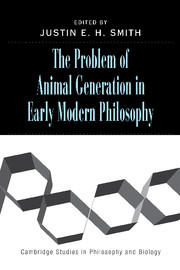Book contents
- Frontmatter
- Contents
- List of Contributors
- Introduction
- I THE DAWNING OF A NEW ERA
- 1 The Comparative Study of Animal Development: William Harvey's Aristotelianism
- 2 Monsters, Nature, and Generation from the Renaissance to the Early Modern Period: The Emergence of Medical Thought
- II THE CARTESIAN PROGRAM
- III THE GASSENDIAN ALTERNATIVE
- IV SECOND-WAVE MECHANISM AND THE RETURN OF ANIMAL SOULS, 1650–1700
- V BETWEEN EPIGENESIS AND PREEXISTENCE: THE DEBATE INTENSIFIES, 1700–1770
- VI KANT AND HIS CONTEMPORARIES ON DEVELOPMENT AND THE PROBLEM OF ORGANIZED MATTER
- VII KANT AND THE BEGINNINGS OF EVOLUTION
- Bibliography
- Index
2 - Monsters, Nature, and Generation from the Renaissance to the Early Modern Period: The Emergence of Medical Thought
Published online by Cambridge University Press: 06 August 2009
- Frontmatter
- Contents
- List of Contributors
- Introduction
- I THE DAWNING OF A NEW ERA
- 1 The Comparative Study of Animal Development: William Harvey's Aristotelianism
- 2 Monsters, Nature, and Generation from the Renaissance to the Early Modern Period: The Emergence of Medical Thought
- II THE CARTESIAN PROGRAM
- III THE GASSENDIAN ALTERNATIVE
- IV SECOND-WAVE MECHANISM AND THE RETURN OF ANIMAL SOULS, 1650–1700
- V BETWEEN EPIGENESIS AND PREEXISTENCE: THE DEBATE INTENSIFIES, 1700–1770
- VI KANT AND HIS CONTEMPORARIES ON DEVELOPMENT AND THE PROBLEM OF ORGANIZED MATTER
- VII KANT AND THE BEGINNINGS OF EVOLUTION
- Bibliography
- Index
Summary
One of the most striking features of the discussion of monsters in the sixteenth century lies in the variety of texts in which they were discussed. In the second part of the sixteenth century, illustrations of monsters were featured with increasing frequency in the new editions of the Cosmographia universalis of Sebastian Münster (first edition 1552), in the volumes of the Historia animalium of Conrad Gesner (first volume 1551; fourth volume 1558), in the 1557 edition of the Prodigiorum ac ostentorum chronicon of Lycosthenes and in the enlarged editions of the Histoires prodigieuses of Pierre Boaistuau (first published in 1560). It would still be a number of decades, following the middle of the sixteenth century, before monsters and their causes were to become the specific subject of study by surgeons and physicians.
Jakob Rüff, a Zurich surgeon, and Ambroise Paré, a French surgeon, were the first to include studies of monsters in medical treatises. These treatises were reprinted and translated many times after their first editions, Rüff's in German in 1553 and Paré's in French in 1573. When describing and drawing monsters, Rüff and, to an even greater extent, Paré borrowed information on the subject from many sources.
Monsters were considered rare and generally were thought not to live long. Since very few doctors or surgeons directly observed the monsters they reported on, most rested content with gleaning as much information as they could from the works of physicians such as Hippocrates, philosophers such as Aristotle, and philosopher-theologians such as Augustine and Albertus Magnus, as well as from the books of historiographers such as Hartman Schedel, Conrad Lycosthenes, and Pliny the Elder; cosmographers such as Sebastian Münster, and even novelists such as Heliodorus and poets such as Ovid.
- Type
- Chapter
- Information
- Publisher: Cambridge University PressPrint publication year: 2006
- 2
- Cited by



